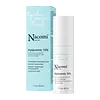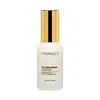What's inside
What's inside
 Key Ingredients
Key Ingredients

 Benefits
Benefits

 Concerns
Concerns

 Ingredients Side-by-side
Ingredients Side-by-side

Water
Skin ConditioningGlycerin
HumectantHydrolyzed Yeast Extract
Skin ConditioningPropanediol
SolventHydrolyzed Glycosaminoglycans
HumectantSodium Hyaluronate
HumectantHyaluronic Acid
HumectantHydrolyzed Hyaluronic Acid
HumectantSodium Hyaluronate Crosspolymer
HumectantCetyl Hydroxyethylcellulose
Emulsion StabilisingLecithin
EmollientXanthan Gum
EmulsifyingCellulose Gum
Emulsion StabilisingCellulose
AbsorbentFructose
HumectantGlucose
HumectantInulin
Skin ConditioningRaspberry Ketone
MaskingSodium Citrate
BufferingPolyglucuronic Acid
Skin ConditioningDehydroacetic Acid
PreservativeBenzyl Glycol
SolventEthylhexylglycerin
Skin ConditioningPotassium Sorbate
PreservativeSodium Benzoate
MaskingBenzyl Alcohol
PerfumingWater, Glycerin, Hydrolyzed Yeast Extract, Propanediol, Hydrolyzed Glycosaminoglycans, Sodium Hyaluronate, Hyaluronic Acid, Hydrolyzed Hyaluronic Acid, Sodium Hyaluronate Crosspolymer, Cetyl Hydroxyethylcellulose, Lecithin, Xanthan Gum, Cellulose Gum, Cellulose, Fructose, Glucose, Inulin, Raspberry Ketone, Sodium Citrate, Polyglucuronic Acid, Dehydroacetic Acid, Benzyl Glycol, Ethylhexylglycerin, Potassium Sorbate, Sodium Benzoate, Benzyl Alcohol
Water
Skin ConditioningIsoamyl Laurate
Emollient1,2-Hexanediol
Skin ConditioningIsopentyldiol
HumectantInositol
HumectantGlycerin
HumectantInulin
Skin ConditioningArginine
MaskingDipalmitoyl Hydroxyproline
Skin ConditioningHyaluronic Acid
HumectantSodium Hyaluronate
HumectantThymus Vulgaris Flower/Leaf Extract
MaskingHoney Extract
HumectantPropolis Extract
Skin ConditioningRoyal Jelly Extract
Skin ConditioningSh-Polypeptide-123
Skin ProtectingCurcuma Longa Root Extract
MaskingDiisostearyl Malate
EmollientMaltooligosyl Glucoside
Skin ConditioningPropanediol
SolventBis-Diglyceryl Polyacyladipate-1
EmollientHydrogenated Starch Hydrolysate
HumectantGlycogen
HumectantCeratonia Siliqua Gum
EmollientMelia Azadirachta Leaf Extract
Skin ConditioningSodium Phytate
Melia Azadirachta Flower Extract
Skin ConditioningCorallina Officinalis Extract
Skin ConditioningCellulose
AbsorbentFructose
HumectantGlucose
HumectantOcimum Basilicum Flower/Leaf Extract
TonicOrmenis Multicaulis Oil
MaskingOcimum Sanctum Leaf Extract
Skin ConditioningAroma
Arachidyl Alcohol
EmollientCitrus Aurantium Amara Flower Extract
RefreshingBehenyl Alcohol
EmollientSclerotium Gum
Emulsion StabilisingArachidyl Glucoside
EmulsifyingCellulose Gum
Emulsion StabilisingCetearyl Alcohol
EmollientLecithin
EmollientLimonene
PerfumingLinalool
PerfumingXanthan Gum
EmulsifyingWater, Isoamyl Laurate, 1,2-Hexanediol, Isopentyldiol, Inositol, Glycerin, Inulin, Arginine, Dipalmitoyl Hydroxyproline, Hyaluronic Acid, Sodium Hyaluronate, Thymus Vulgaris Flower/Leaf Extract, Honey Extract, Propolis Extract, Royal Jelly Extract, Sh-Polypeptide-123, Curcuma Longa Root Extract, Diisostearyl Malate, Maltooligosyl Glucoside, Propanediol, Bis-Diglyceryl Polyacyladipate-1, Hydrogenated Starch Hydrolysate, Glycogen, Ceratonia Siliqua Gum, Melia Azadirachta Leaf Extract, Sodium Phytate, Melia Azadirachta Flower Extract, Corallina Officinalis Extract, Cellulose, Fructose, Glucose, Ocimum Basilicum Flower/Leaf Extract, Ormenis Multicaulis Oil, Ocimum Sanctum Leaf Extract, Aroma, Arachidyl Alcohol, Citrus Aurantium Amara Flower Extract, Behenyl Alcohol, Sclerotium Gum, Arachidyl Glucoside, Cellulose Gum, Cetearyl Alcohol, Lecithin, Limonene, Linalool, Xanthan Gum
 Reviews
Reviews

Ingredients Explained
These ingredients are found in both products.
Ingredients higher up in an ingredient list are typically present in a larger amount.
Cellulose is the main component of plant cell walls. It is used as an emulsifier, absorbent, and texture enhancer.
This ingredient has many functions:
Fun fact: Cellulose is the most abundant form of organic polymer on Earth.
Learn more about CelluloseCellulose Gum is a water-soluble polymer that comes from cellulose. It is used to change the texture of a product and to help stabilize emulsions.
As an emulsifier, cellulose gum specifically thicken the texture of water-based products.
This ingredient is considered hypoallergenic and non-toxic. Cellulose Gum can be found in cosmetics, food, and other household goods such as paper products.
Learn more about Cellulose GumGlucose is a simple sugar and is the most important source of energy in all organisms.
In skincare, glucose is used to hydrate the skin. It also acts as a prebiotic for our natural biome.
Glucose is hydrating due to its humectant property. As a humectant, glucose draws moisture from the air and from deeper levels in the skin.
Our skin contains many sugars that act as prebiotics and help strengthen our natural microbiome. Having a healthy microbiome helps protect our skin from harmful bacteria and other contaminants.
Studies show glucose may help with fading discoloration and pigmentation. This is because our skin metabolizes glucose into lactic acid. Lactic acid is an AHA that helps exfoliate the top layer of skin.
Learn more about GlucoseGlycerin is already naturally found in your skin. It helps moisturize and protect your skin.
A study from 2016 found glycerin to be more effective as a humectant than AHAs and hyaluronic acid.
As a humectant, it helps the skin stay hydrated by pulling moisture to your skin. The low molecular weight of glycerin allows it to pull moisture into the deeper layers of your skin.
Hydrated skin improves your skin barrier; Your skin barrier helps protect against irritants and bacteria.
Glycerin has also been found to have antimicrobial and antiviral properties. Due to these properties, glycerin is often used in wound and burn treatments.
In cosmetics, glycerin is usually derived from plants such as soybean or palm. However, it can also be sourced from animals, such as tallow or animal fat.
This ingredient is organic, colorless, odorless, and non-toxic.
Glycerin is the name for this ingredient in American English. British English uses Glycerol/Glycerine.
Learn more about GlycerinHyaluronic acid is naturally found in healthy skin. It is a humectant, meaning it draws moisture to your skin.
This ingredient helps hydrate, soothe, and protect the skin.
What makes hyaluronic acid so hydrating? It has the capacity to bind or hold large amounts of water.
Fun fact: It is already naturally found in our bodies, such as the fluids of our eyes and our joints.
Studies find this ingredient to have anti-inflammatory and anti-microbial properties. This can help speed up wound-healing.
Hyaluronic acid can be irritating if the molecule has a low-molecular weight, or if the molecules are small.
One study found low-molecular weight hyaluronic acid to be pro-inflammatory, meaning some people may experience irritation. This is because our bodies use hyaluronic acid in the wound-healing process to signal to our bodies, via irritation, that something needs healing.
The same study found high-molecular weight hyaluronic acid to be anti-inflammatory.
These are some other common types of Hyaluronic Acid:
Learn more about Hyaluronic AcidInulin is a polysaccharide (carbohydrate) with prebiotic and antioxidant properties.
The majority of inulin is extracted from chicory, but can also be obtained from other plants such as garlic, onion, asparagus, and sugarcane.
Studies show inulin may help with controlling your skin's natural microbiota when applied topically.
The antioxidant potential of inulin varies depending on the source.
Learn more about InulinLecithin is a term for a group of substances found in the cell membranes of plants, animals, and humans. They are made up of mixture of phospholipids.
This ingredient has emollient and emulsifying properties.
As an emollient, lecithen helps soften the skin and creates a barrier to keep moisture in.
As an emulsifier, it also helps prevent water and oil ingredients from separating. Lecithin can also help ingredients be better absorbed by the skin.
This is because the phospholipids in lecithin produce liposomes. Liposomes help other ingredients get through the skin barrier.
Depending on the source of this ingredient, lecithin may not be fungal acne safe. This is because some sources of lecithin come from soybean oil, which may feed the malassezia yeast that feeds fungal acne.
We recommend reaching out to the brand you are purchasing from to inquire about the source of their lecithin.
Some other names for this ingredient include soy lecithin and deoiled soy lecithin.
Learn more about LecithinPropanediol is an all-star ingredient. It softens, hydrates, and smooths the skin.
It’s often used to:
Propanediol is not likely to cause sensitivity and considered safe to use. It is derived from corn or petroleum with a clear color and no scent.
Learn more about PropanediolSodium Hyaluronate is hyaluronic acid's salt form. It is commonly derived from the sodium salt of hyaluronic acid.
Like hyaluronic acid, it is great at holding water and acts as a humectant. This makes it a great skin hydrating ingredient.
Sodium Hyaluronate is naturally occurring in our bodies and is mostly found in eye fluid and joints.
These are some other common types of Hyaluronic Acid:
Learn more about Sodium HyaluronateWater. It's the most common cosmetic ingredient of all. You'll usually see it at the top of ingredient lists, meaning that it makes up the largest part of the product.
So why is it so popular? Water most often acts as a solvent - this means that it helps dissolve other ingredients into the formulation.
You'll also recognize water as that liquid we all need to stay alive. If you see this, drink a glass of water. Stay hydrated!
Learn more about WaterXanthan gum is used as a stabilizer and thickener within cosmetic products. It helps give products a sticky, thick feeling - preventing them from being too runny.
On the technical side of things, xanthan gum is a polysaccharide - a combination consisting of multiple sugar molecules bonded together.
Xanthan gum is a pretty common and great ingredient. It is a natural, non-toxic, non-irritating ingredient that is also commonly used in food products.
Learn more about Xanthan Gum